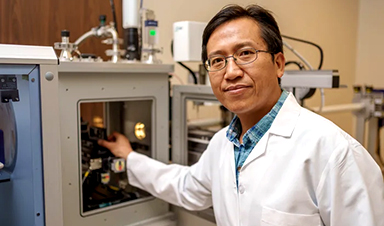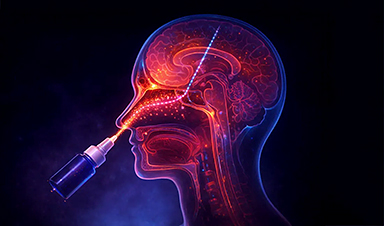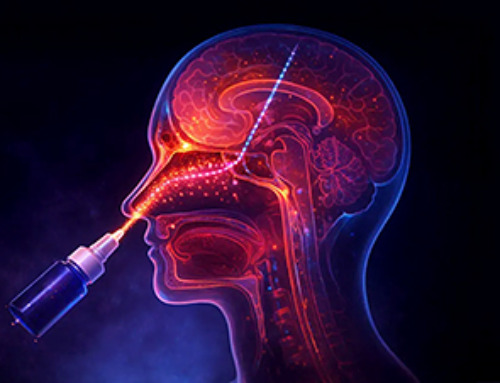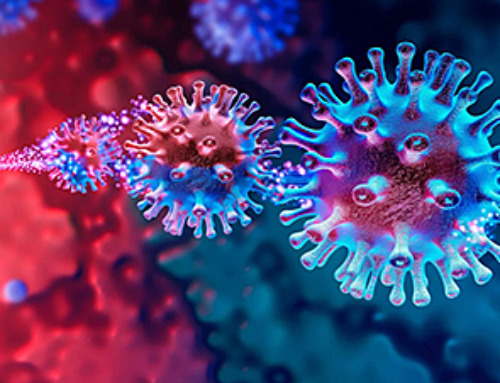Over 2.8 million Americans get antibiotic-resistant bacterial infections annually, and about 35,000 of those patients do not make it through their infection, according to the Centers for Disease Control and Prevention.
Hongjun (Henry) Liang, Ph.D., of the Texas Tech University Health Sciences Center (TTUHSC) Department of Cell Physiology and Molecular Biophysics, has largely focused his research on creating novel nanoparticles known as nanoantibiotics that address bacterial infections, particularly those that are resistant to treatment with commonly used antibiotics, to find solutions to the problem of antibiotic resistance.
As of July 26th, 2022, a US patent titled “Hydrophilic Nanostructured Membrane Active Antimicrobials With High Activity, Selectivity And Biodegradability” had been issued in connection with Liang’s work, enabling the Liang laboratory team to manufacture the innovative nanoantibiotics.
We have a lot of antibiotics already being used in the clinics, and many of them are quite effective to ordinary infections. But we are facing this increasing challenge with MRSA (methicillin-resistant staphylococcus aureus) and other kinds of drug-resistant bacteria, which are the bacteria that turns ordinary infections into life-threatening events.
Hongjun Liang, Department of Cell Physiology and Molecular Biophysics, Texas Tech University Health Sciences Center
The ability of a molecule to repel water (hydrophobicity) or to attract water and dissolve in it (hydrophilicity) has been shown to have a major impact on cells in previous studies. According to Liang, a material will have a higher negative effect the more hydrophobic it is.
He emphasized that there is, however, no quantitative benchmark for the acceptable level of hydrophobicity.
Liang added, “Basically, you can kill bacteria when you increase hydrophobicity. But it also will kill healthy cells, and we don’t want that.”
The Liang team created unique hydrophilic nanoantibiotics in a study published in January 2022 in Nature Communications. These nanoantibiotics had the appearance of tiny hairy spheres and were made of many hydrophilic polymer brushes grafted onto silica nanoparticles of various sizes.
These man-made substances, which are also produced by Liang’s lab, are intended to kill bacteria by disrupting their membranes by utilizing a distinct method of membrane remodeling that affects bacterial membranes while leaving mammalian cells unharmed.
This was the third paper on nanoantibiotics that the Liang lab has published. The first and second publications that described the hydrophilic nanoantibiotic design approach were released in 2017 by ACS Infectious Disease and in 2020 by Biomacromolecules.
Both were highlighted by Chemical & Engineering News and featured as cover stories in their respective journals.
Liang said his team is now concentrating on a two-pronged approach to enhance and improve the nanoantibiotics for use in patients, armed with the three published findings and the patent.
Pushing for clinical trials is the first strategy, which Liang defined as the research and academic component of his approach. The Liang lab will begin that procedure by submitting new applications for federal funding that support animal studies and ultimately result in clinical trials on human subjects.
He stated, “That is more like the research and academic side of our effort.”
Working with the Texas Tech University Innovation Hub to assist in the commercialization of Liang’s lab’s invention is the second element of his approach.
“By taking the training opportunity on research commercialization from our Innovation Hub, hopefully, we are able to identify interested parties in the pharmaceutical industry who are able or willing to collaborate with us. One of our likely directions is to apply for an SBIR (Small Business Innovation Research) grant to pilot scale production. That’s our two-pronged approach,” stated Liang.
Infection is a major concern for both scientists and practicing physicians, according to Liang. By harnessing innovation to develop a new generation of antibiotics, he hopes to be able to overcome this issue.
Liang concluded, “That is our goal and we are well on our way to that. I can’t say this is the only way forward; of course, there are many different ways. The novelty of our contribution is to tackle this challenge by designing antibiotics from a nanoengineering point of view. This is a very new path that is not well explored, and we are proud of our progress so far.”
News
Miller School Researchers Pioneer Nanovanilloid-Based Brain Cooling for Traumatic Injury
A multidisciplinary team at the University of Miami Miller School of Medicine has developed a breakthrough nanodrug platform that may prove beneficial for rapid, targeted therapeutic hypothermia after traumatic brain injury (TBI). Their work, published in ACS [...]
COVID-19 still claims more than 100,000 US lives each year
Centers for Disease Control and Prevention researchers report national estimates of 43.6 million COVID-19-associated illnesses and 101,300 deaths in the US during October 2022 to September 2023, plus 33.0 million illnesses and 100,800 deaths [...]
Nanomedicine in 2026: Experts Predict the Year Ahead
Progress in nanomedicine is almost as fast as the science is small. Over the last year, we've seen an abundance of headlines covering medical R&D at the nanoscale: polymer-coated nanoparticles targeting ovarian cancer, Albumin recruiting nanoparticles for [...]
Lipid nanoparticles could unlock access for millions of autoimmune patients
Capstan Therapeutics scientists demonstrate that lipid nanoparticles can engineer CAR T cells within the body without laboratory cell manufacturing and ex vivo expansion. The method using targeted lipid nanoparticles (tLNPs) is designed to deliver [...]
The Brain’s Strange Way of Computing Could Explain Consciousness
Consciousness may emerge not from code, but from the way living brains physically compute. Discussions about consciousness often stall between two deeply rooted viewpoints. One is computational functionalism, which holds that cognition can be [...]
First breathing ‘lung-on-chip’ developed using genetically identical cells
Researchers at the Francis Crick Institute and AlveoliX have developed the first human lung-on-chip model using stem cells taken from only one person. These chips simulate breathing motions and lung disease in an individual, [...]
Cell Membranes May Act Like Tiny Power Generators
Living cells may generate electricity through the natural motion of their membranes. These fast electrical signals could play a role in how cells communicate and sense their surroundings. Scientists have proposed a new theoretical [...]
This Viral RNA Structure Could Lead to a Universal Antiviral Drug
Researchers identify a shared RNA-protein interaction that could lead to broad-spectrum antiviral treatments for enteroviruses. A new study from the University of Maryland, Baltimore County (UMBC), published in Nature Communications, explains how enteroviruses begin reproducing [...]
New study suggests a way to rejuvenate the immune system
Stimulating the liver to produce some of the signals of the thymus can reverse age-related declines in T-cell populations and enhance response to vaccination. As people age, their immune system function declines. T cell [...]
Nerve Damage Can Disrupt Immunity Across the Entire Body
A single nerve injury can quietly reshape the immune system across the entire body. Preclinical research from McGill University suggests that nerve injuries may lead to long-lasting changes in the immune system, and these [...]
Fake Science Is Growing Faster Than Legitimate Research, New Study Warns
New research reveals organized networks linking paper mills, intermediaries, and compromised academic journals Organized scientific fraud is becoming increasingly common, ranging from fabricated research to the buying and selling of authorship and citations, according [...]
Scientists Unlock a New Way to Hear the Brain’s Hidden Language
Scientists can finally hear the brain’s quietest messages—unlocking the hidden code behind how neurons think, decide, and remember. Scientists have created a new protein that can capture the incoming chemical signals received by brain [...]
Does being infected or vaccinated first influence COVID-19 immunity?
A new study analyzing the immune response to COVID-19 in a Catalan cohort of health workers sheds light on an important question: does it matter whether a person was first infected or first vaccinated? [...]
We May Never Know if AI Is Conscious, Says Cambridge Philosopher
As claims about conscious AI grow louder, a Cambridge philosopher argues that we lack the evidence to know whether machines can truly be conscious, let alone morally significant. A philosopher at the University of [...]
AI Helped Scientists Stop a Virus With One Tiny Change
Using AI, researchers identified one tiny molecular interaction that viruses need to infect cells. Disrupting it stopped the virus before infection could begin. Washington State University scientists have uncovered a method to interfere with a key [...]
Deadly Hospital Fungus May Finally Have a Weakness
A deadly, drug-resistant hospital fungus may finally have a weakness—and scientists think they’ve found it. Researchers have identified a genetic process that could open the door to new treatments for a dangerous fungal infection [...]





















